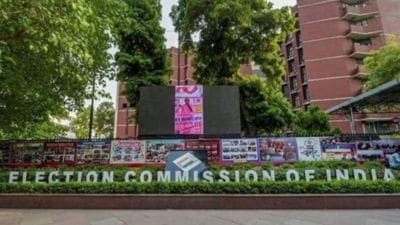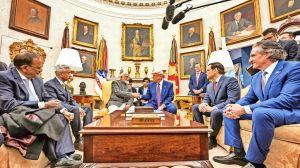Military Digest: Recalling Indian Navy’s march to ‘Indianisation’ and its first Indian chief
With Navy Day around the corner, a look at the milestones in the Indian Navy’s journey towards self-governance.
 Vice Admiral Ram Dass Katari
Vice Admiral Ram Dass KatariThe approaching Navy Day, December 4, is the right occasion to look back at some historical aspects of the Indian Navy and its evolution under British officers, continuing well into the post-Independence era.
It was in 1958, 11 years after Independence, that the Navy finally got an Indian naval chief with the appointment of Vice Admiral Ram Dass Katari. Interestingly, Katari and his successor, Admiral B S Soman, had been the chiefs in the rank of vice admiral and the appointment had been upgraded to the admiral rank when Admiral Adhar Kumar Chatterjee took over in 1966. In November 1980, the President of India appointed R D Katari and B S Soman to the honorary ranks of admiral with effect from October 21, 1980.
Slow start to ‘Indianisation’
After Independence, the Royal Indian Navy, as it was called till January 26, 1950, was the slowest among the three services to get nationalised. Even after India became a republic, the preponderance of British officers in the service continued far beyond what was in effect in the Army or the Indian Air Force.
The naval chief in 1948, Admiral William Edward Parry, recognised this anomaly and commented that some time must elapse before the Navy could dispense with the assistance and advice of British officers altogether. Nevertheless, he stressed that it is of the utmost importance that all posts should be filled by Indian officers as soon as possible.
In April 1958 the senior-most officer of the Navy, Rear Admiral R D Katari, who was at the time the flag officer commanding the Indian fleet, was appointed the naval chief.
The Navy, which actually came into being as the Indian Marine in 1613, had so far been commanded only by British officers. Under the East India Company, it was commanded by comparatively low-ranking officers. Once the Navy was taken over by the British Crown in 1858, the service operated as an adjunct to the Royal Navy.
From September 1934, when the Indian Navy Discipline Act was passed by the Indian legislature, the service came to be known as the Royal Indian Navy and its command was then vested with the flag officer commanding Royal Indian Navy. But the supreme command of the navy, as well as the other two services, was given to the commander-in-chief, who was also a member of the governor-general’s Executive Council.
After Independence, the first two commanders-in-chief of the Indian Navy were Rear Admiral John Talbot Savignac, Admiral Sir Edward Parry, Admiral Sir Mark Pizey and Vice Admiral Sir Stephen Carlill.
The Indian naval chief
Admiral R D Katari had the proud distinction of holding many “firsts” in academic and professional careers. He was born at Chingleput (now Chengalpattu) in Tamil Nadu and spent his childhood and youth in Hyderabad. After initial schooling, he joined the training ship Dufferin and stood first in the entrance examination.
He has the unique triple distinction of being the first cadet to join Dufferin when it was founded in 1927, being the first winner of the Viceroy’s Gold Medal and becoming the first member representing the ex-cadets on Dufferin’s governing body.
In World War II, he served in the Atlantic and Indian Oceans and held a variety of appointments both afloat and ashore. Having specialised in anti-submarine work, he was for a while an instructor in the anti-submarine school.
Subsequent to the war, he held important sea commands. He was responsible for clearing the mines that had been laid in the Andaman and Nicobar areas. Later the command of the naval forces that took part in the defence operations off the Kathiawar coast devolved on him when he was in command of the INS Kistna. He later commanded the first cruiser of the Indian Navy, the INS Delhi.
He was promoted to the rank of captain in December 1948, about two months before he took over as chief of personnel at the naval headquarters. For about a year from December 1951, he was the captain of the Indian Navy’s destroyer squadron and commanding officer of the INS Rajput.
After attending a course at the Imperial Defence College in the United Kingdom in 1953, he took over as deputy chief of naval staff in 1954 and was promoted to the rank of commodore. In the same year, he officiated as the commander-in-chief of the Indian Navy and became the first Indian officer to do so.
In March 1956, he was promoted as a rear admiral.












